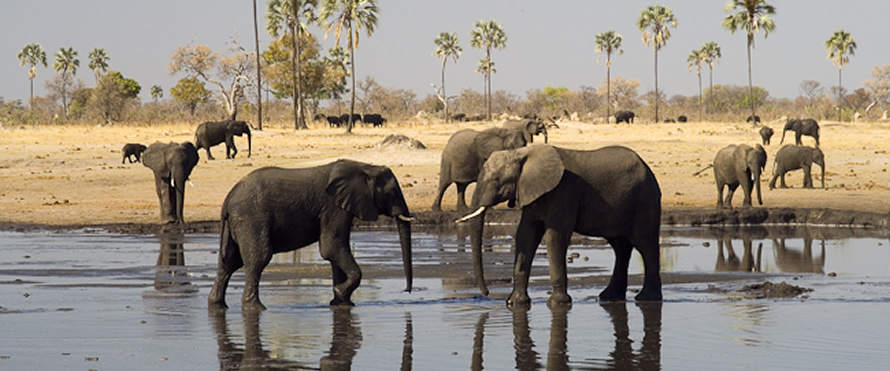
The Sunday News

IN Hwange National Park, both flora and fauna are subjected to day after day of cloudless skies, scotching heat and unrelenting sun.
In some years it never rains a drop for months on end. The sun is always angry, the vegetation and wild animals are used to this harsh reality but they soldier on while some succumb to the vagaries of the hot weather and die.
But they say until the lion masters the art of telling his side of the story, the tale of the hunt will always glorify the hunter!
And the above adage literally awakened my impulses when I recently took an excursion into the Hwange National Park, Zimbabwe and indeed one of Africa’s largest wildlife jungles.
The purpose of a date with Hwange National Park was simply to raise the adrenaline of my festive mood when I realised that the rainy season in Hwange National Park means a lot more than just a change in season to both flora and fauna.
It is a beautiful turn of events for the wildlife in this park, a tale that unfortunately wildlife on its own, cannot tell. A tale that can thus only be told from a tourist’ perspective.
It is a moody Saturday and the tinder dry Hwange National Park is smiling to the joys of the first rains that came in the form of a light drizzle as spring paves way for the wet season.
In the vast and arid park, home to over 45 000 elephants among an array of other game species, water is larger than life.
The rainy season brings a new lease of life to both flora and fauna.
Here, life revolves around artificial waterholes which are pumped 24/7 by the Zimbabwe National Parks and Wildlife Authority, with no rivers parks pump a whopping 50 000 litres of water from boreholes dotted all over the 14 800 square kilometre park.
And due to pressure and demand for the precious liquid, the water pumps always break down. So, apart from foraging for the food, which is again hard to come by as vegetation is ever grazed and browsed by marauding jumbos, every specie has to remember and spare some time for a trip to the water hole. This, then, presents a perfect theatre of the jungle, where predators prey on others. For, it is at the water hole that predators forever stalk their prey but with the scarcity of water every species, no matter how vulnerable, has to embark on this fiery but important expedition to the water hole to quench their thirst.
This is why Hwange National Park is a spectacle; every tourist is guaranteed his or her own moments, a real encounter with the wild.
A close encounter with every species, be it elephants, lions, giraffe, zebra, buffalo, warthog, impala, you name them, even the elusive leopard too, frequent the water hole at night.
And with the coming of the rains, Hwange National Park becomes an even more spectacle with more and more plains game grazing on the roadside, attracted by the lush greenery. Mud-ruts on the dusty roads also attract the thirst.
Under the drizzle, wild animals parade along game drive ways as if to thank the heavens for the rains while at the same time displaying their God-given colours to the tourists.
In their camouflage, zebras groom themselves, ears up and ever alert.
Giraffes, those tiny long legs and neck, in their beige and white spots scotch like combat, take advantage of the daunting neck to feed on shooting tree leaves.
Kudus, with matching back stripes, feed on shooting stunted bush shrubbery, corkscrew horns selling the bulls away while fluffy long ears depict females.
In the park, shrubs and medium-sized trees are almost of the same height, showing a graze-line as fresh as a schoolboy’s haircut. They never grow as again and again they get “pruned” by the increasing number of elephants.
A cast into the horizon gives one a sorry state on how trees and bush shrubbery have succumbed to being foraged ever and ever again, by the wild animals. Deep in the heart of the park, a pride of four lionesses lay under a shade guarding their kill, a huge elephant carcass.
Parks and Wildlife officials said a pride of 14 lions were responsible for the downing of this huge elephant. When the need to get something to eat arises, lions team up and with teamwork, no chore is insurmountable, they can kill anything regardless of size. Incredible!
Going further into the jungle, we stumbled upon a herd of impala to our right — heads high, ears flicking forward and backwards showing that they had picked the droning of our approaching car. One by one they took off on spindly legs.
Some distance away in the shooting prairie, another heard of fat zebras with round shaped backs graze from the small shrubbery that have managed to stand the abuse from elephants. Fashionable and smart in their God-given white and black striped jackets, they elegantly swung their tails to ward-off flies.
In their startling identity and adroitness, they stared at us with some degree of arrogance as our slowly moving vehicle passed.
The rains had come bringing a new lease of life!



